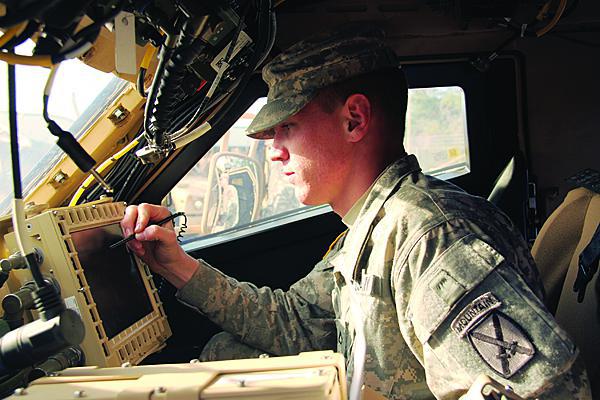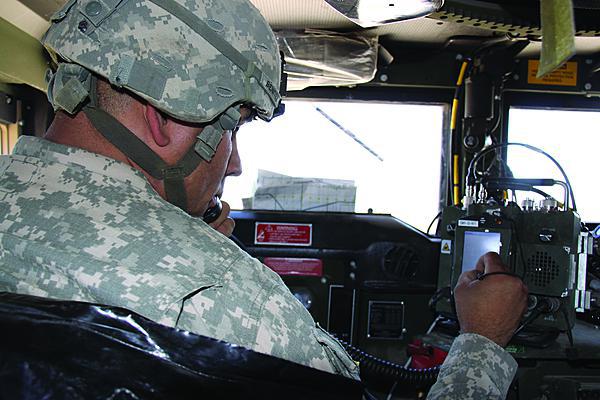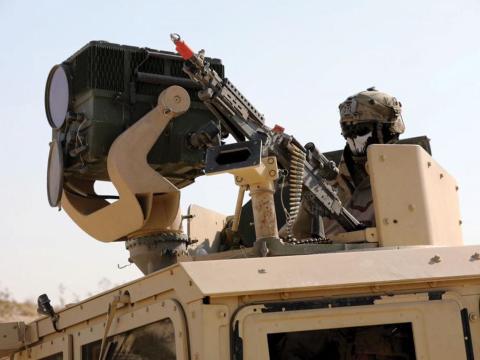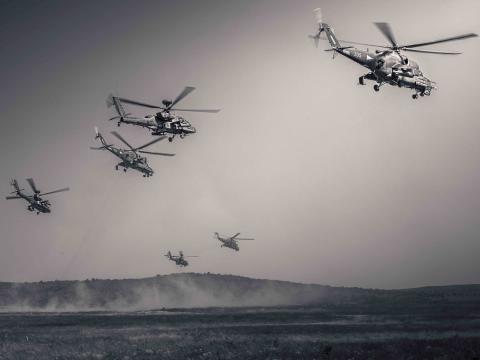Soldiers Shake Up NIE
Moving forward through sequester, next fiscal year's evaluations include new contracts and contacts.
As the U.S. Army prepares its network of the future, it plans to make some changes to the way it approaches working with government and private partners. The moves will increase interoperability downrange while attempting to shorten the ever-frustrating acquisition cycle that keeps the military behind the curve in implementing cutting-edge technologies.
Soldiers are starting to lay the groundwork for, and intend on inviting, airmen and Marines to participate in Network Integration Evaluations (NIEs) 14.1 and 14.2, scheduled for fall 2013 and spring 2014 respectively. They also are preparing to expand live, virtual and constructive (LVC) features, which will facilitate bringing in the new participants, because they may be able to exercise from remote locations. In a previous iteration, the Army had one of its own brigades carry out its parts through a simulation. Brig. Gen. Randal Dragon, USA, commanding general of the Army’s Brigade Modernization Command, explains that planners are shooting to find the LVC balance in 14.1 that will help them understand what they need to do to accommodate the joint network in 14.2. “We’re still in very, very early preliminary design stages,” he states. Before connecting a major joint, coalition or interagency partner to the network, the Army has to determine how to reduce risks and costs. Officials are attempting to find the right mix to enable the joint requirements while maintaining the momentum of systems of evaluation.
The military has conducted operations in partnership formats for years. Regardless of theater, having compatible, modular, plug-in capabilities to bridge gaps helps everyone to assimilate and start missions. “We simply must understand our own networks,” Gen. Dragon states. A few joint partners already have participated in a less comprehensive manner in prior NIEs, but in 14.2, their roles will become more formalized and robust. The general says not to rule out that these groups could take part in bigger ways before 14.2, but the emphasis for including them is on that exercise.
Col. Mark Elliott, USA, director, G-3/5/7 LandWarNet/Mission Command Directorate, says working with the Air Force and Marine Corps is important for many reasons, including the fact that the Army owns few ships or aircraft, so it often relies on its sister services for transport. “As you are probably aware, we do a very good job in the U.S. services on how we interface with one another,” he states. “But as we continue to develop these new systems, we want to maintain that interoperability.” This effort entails working together to develop capabilities.
Including outside participants should require few adjustments, at least in terms of connections, according to the colonel. “Ideally if we get it right, we don’t have to do anything different,” he says. Soldiers will use their regular equipment to communicate with their partners’ systems. “If we have our interfaces right, it’s a seamless back and forth,” Col. Elliott adds. The Army plans to take advantage of NIE 14.1 to start to shape its engagement for the next one. Additional joint initiatives include potentially marrying the NIE with other events such as Bold Quest—an exercise focused on technology and coalition interoperability—though no plans are solidified.
Industry also can expect changes to its involvement in the evaluations, which should work to its benefit. According to an Army document, the service branch is solidifying its NIE acquisition plan to allow for target procurement of capabilities outside of official programs of records (PORs). The Army already has made some such purchases but recognizes a need for continuous improvement. As a result, it is implementing an acquisition plan that, according to the document, “provides a formal mechanism for streamlined competitive procurement of non-POR systems that show promise out of the NIE.”
Companies that participated in the previous evaluations responded to sources sought notifications. Moving forward, officials plan to spend the first evaluation each year assessing industry solutions as outlined in the sources sought notices, but then they will use information collected to issue targeted requests for proposal (RFPs) for participation in future NIEs. RFPs differ from sources sought because they culminate in a funded contract. The first NIE RFP was released in December 2012 in an attempt to procure vehicle tactical routers for 14.1. Col. Elliott explains that the Army wants to take what industry brings to the NIE and use that to become part of the future capability sets. “Our goal is to make sure industry doesn’t lose patience as we continue to develop that concept,” he says.
Many industry partners participate in the NIEs on a regular basis. Their work focuses not only on networks—though that remains the central theme—but also on other tools to help soldiers in the field. During 13.2, for example, soldiers evaluated ear plugs.
The Army wraps up 13.2 this month, setting the stage for the evolution to joint evaluations in 14.1 and 14.2 while helping to build Capability Set 14. Previous NIEs focused on Capability Set 13. The 10th Mountain Division is deploying with that toolset, which is expected to enhance the unit’s mobility. Soldiers from 10th Mountain will provide feedback, and teams of evaluators are deploying with them to determine what works correctly and what needs additional development. The original design of the agile process inherent in the NIEs is to develop capabilities stateside and then field them with a Brigade Combat Team as part of the Army Force Generation. The deployment with 10th Mountain is the beginning of the fruition of that effort (see "Making Tactical Communications History").
NIE 13.2 includes several main thrusts. Experiments with the Army’s Warfighter Information Network–Tactical Increment 2 likely are the most important aspect of 13.2. That system is a key to enabling on-the-move communications for soldiers (see "Army Network Testing Increases Commonality"). Gen. Dragon says previous evaluations have led to insights about the cognitive ability of leaders to absorb information from such systems. Other focus areas are integrating and modernizing the network as well as providing feedback to Army leaders on mission command on the move to help inform their decisions.
Additional objectives include looking at Nett Warrior—a technology offering dismounted soldiers enhanced situational awareness—as well as unit task reorganization and convergence efforts in areas such as transport, operations and intelligence, and network operations. NIE 13.2 includes a competitive facet with a continuous scenario in a complex environment, including operations up to the Brigade Combat Team level. Gen. Dragon points out the work performed during the NIEs benefits more than material solutions. Instead, efforts span the entire doctrine, organization, training, materiel, leadership and education, personnel and facilities, or DOTMLPF, spectrum. This scope allows better organization and leader development across the Army to improve system use in the operational environment.
The importance of the NIE to the overall Army is demonstrated in part through plans to keep the events going as scheduled despite sequestration. “I will tell you, and others will say it, we simply can’t afford not to do the NIE at this point in time,” Gen. Dragon says. Either the Army learns and applies the integration lessons in the NIE, or it will send disorganized, nonintegrated systems out to the force. By learning at the NIEs, the Army can reduce costs down the road.
The general explains that the Army is committed to modernizing its force, which the NIE facilitates while giving soldiers a chance to integrate systems on the ground before they deploy to the field. “The Army is dedicated to the future capability Army [but it’s also] just as committed to the soldiers doing business as we speak right now,” Gen. Dragon explains. Providing troops with technology early in development processes is an effort not carried out elsewhere in the military branch. The general explains that the NIE gives the Army a venue to make incremental improvements. As plans unfold, the service is starting to buy less, more often, which he adds is a positive.
Col. Elliott agrees, saying the NIE’s actions are difficult to duplicate anywhere else. “This is a one-stop shop for us to get a lot of work done in a holistic manner,” he explains. Feedback from soldiers helps shape programs and prevent investment in outdated technology. Col. Elliott believes any prudent planner will continue the NIEs. “The goodness they provide is undeniable in my opinion,” he states, adding that it offers the Army and others a chance to achieve several initiatives in one place. Sequestration is about efficiencies, and the NIE offers that, he concludes.
Also affecting military decisions is the change in U.S. Defense Department emphasis to the Asia-Pacific, which in many places has a highly different climate than the theaters of recent wars. Communications equipment operates differently in distinct ecosystems, so developers and evaluators have to take those factors into consideration during their events. Col. Elliott says technology must withstand tropical, maritime environments to serve usefully in the Pacific. “Those are all things we’re looking at as we continue to mature the NIE,” he states.
Gen. Dragon says the scenario designs that will apply in 14.2 reinforce the precepts in the Asia-Pacific guidance. The scenario is joint and multinational focused and includes a deployable system put into an immature, austere theater. It focuses on early entry along with gaining access, then maintaining operational and tactical momentum.





